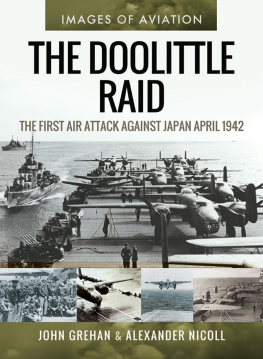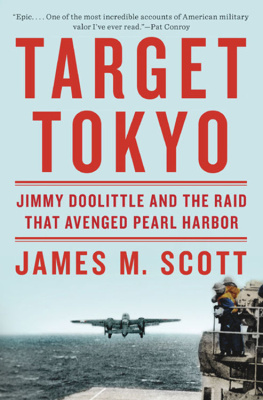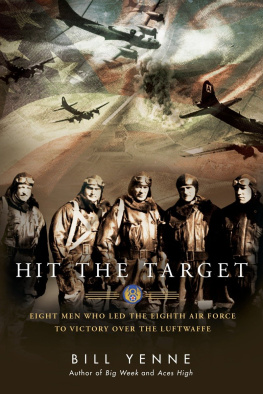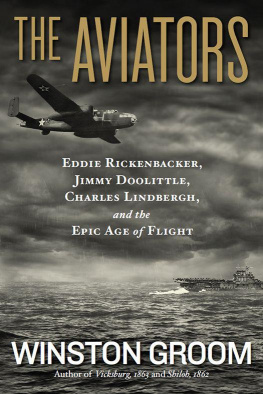This edition is published by PICKLE PARTNERS PUBLISHINGwww.pp-publishing.com
To join our mailing list for new titles or for issues with our bookspicklepublishing@gmail.com
Or on Facebook
Text originally published in 1943 under the same title.
Pickle Partners Publishing 2016, all rights reserved. No part of this publication may be reproduced, stored in a retrieval system or transmitted by any means, electrical, mechanical or otherwise without the written permission of the copyright holder.
Publishers Note
Although in most cases we have retained the Authors original spelling and grammar to authentically reproduce the work of the Author and the original intent of such material, some additional notes and clarifications have been added for the modern readers benefit.
We have also made every effort to include all maps and illustrations of the original edition the limitations of formatting do not allow of including larger maps, we will upload as many of these maps as possible.
LIGHTNING IN THE SKY:
THE STORY OF JIMMY DOOLITTLE
BY
CARL MANN
CHAPTER 1Frank Doolittle, Alaska Prospector
FOR A QUARTER of a century a brilliant American flyer has been blazing a dazzling path through the skies. His courage and flying skill are the spectacular sides of his stalwart character. He has pioneered the aeronautical sciences. Born the son of California pioneers, nurtured as a youth in the Alaskan Klondike, educated in the primary and grade schools of Nome and later in the high schools of California, at Los Angeles Junior College and the University of California, Jimmy Doolittle dropped a budding career as a lightning-fisted prize-fighter to win his wings as a cadet at the start of World War I. James Harold Doolittles career stands out in bold relief as a striking symbol of a red-blooded, free, democratic Americaa story of youthsuccessachievementheroismand unbridled courage and patriotism.
When a gallant crew of American flyers roared over the coast of Japan that sun-drenched day of April 18, 1942, to wreak havoc and destruction on the treacherous Japanese war lords and their humming war plants, few Americans, except those who personally knew him, guessed that Jimmy Doolittle was the man in command. Still fewer Americans knew the real story of this courageous flyera man who was then already the holder of so many daring firsts in records of world aviation that he probably could not name them himself now without consulting the book. Neither did many Americans know that this modest hero and flyer held the degrees of Master of Science and Doctor of Science from the Massachusetts Institute of Technology.
Vaguely familiar may have been the name of Doolittle to many who had sketchily followed the development of aviation. There were those who remembered Jimmy Doolittle as the first aviator to fly from the Atlantic coast to the Pacific in less than one day, back in September, 1922. Still others recalled after that historic mission to Tokyo that Jimmy was the same flyer who astounded the citizens of the United States with his amazing aerial dash from coast to coast again in 1932 to break his old record of 1922, crossing the continent in less than half a dayan event that marked a new era. It was not surprising that the Congressional Medal of Honor should be handed to Doolittle by President Roosevelt on his return from the Tokyo mission, for that was one of the few remaining honors left for him to earn. Thirteen years earlier he had been awarded the Distinguished Flying Cross with the Oak Leaf Cluster.
Today every commercial airliner and military plane that roars into the air wearing the American emblem is guided by instruments pioneered by Jimmy Doolittle. But there are perhaps few of the young pilots flying now under this stout-hearted Major-Generals command in the Mediterranean area, or in any other part of the world, under any other American command, who know that Jimmy was the first man to complete a blind flight, solely by instruments. To him belongs a lions share of the credit for the rapid strides of this new science which has changed the lives of every man, woman, and child on our planet, a science which will in the end determine the destiny of free peoples and the pattern of their future.
It is only incidentally that Jimmy Doolittle was the first pilot to complete the outside loop, a feat which took many heroic mens lives before this brilliant pilot worked out with scientific precision the engineering factors that influenced powered wings in flight.
What startles one in retrospect is to realize that so few Americans have been aware of Doolittle the scientist and successful business executive: the aeronautical engineer who led in the development of aviation gasoline, the life-blood of air power; the prophet who dared to predict the speeds, the power, and the strength of aircraft, and then in his own quiet, methodical manner settled down to prove each of his theories with uncanny accuracy.
Only a few months before Doolittle took his place at the controls of that roaring bomber in which he led those seventy-nine American airmen to the Imperial Nipponese doorstep to unleash the thunder of American anger, he sat in an auditorium in New York City while the President of the Brooklyn Polytechnic Institute conferred upon him the honorary degree of Doctor of Engineering for outstanding achievement in the field of aeronautics. Not many Americans knew about that little ceremony. But for that matter, neither did all of us remember that Jimmy had, long before Pearl Harbor, flown in virtually every country in the world, mapped air routes in South America, won the coveted Mackay Trophy, the Harmon Trophy, and the Schneider Cup race in 1925, or that he had set a worlds seaplane record the same year and a worlds landplane speed record some five years later.
Jimmy was a husband and a father when he climbed into that bomber on the deck of the airplane carrier Hornet , off the coast of Japan; he had two sons who were following in his illustrious footsteps. One is now a pilot in the Army Air Force and the other, a cadet at the United States Military Academy at West Point. In the excitement of the hour when the news was flashed of his gallant raid into the heart of Japan we forgot that Jimmy was old enough to be the father of virtually any youngster in his entire crew of seventy-nine pilots, gunners, navigators, and bombardiers; and although he was not far short of fifty years of age, an age at which few if any pilots remain on active flying duty in either branch of the Air Force, he carried through that mission with a youthful spirit of comradeship and daring equal to any man in his crew who was twenty-five years his junior.
The flame that burns in the heart of this pilot is one that has leaped up in the hearts of all good Americans since the landing on Plymouth Rock. For the history of the Doolittles is one of American history reaching back ten generations. According to the records of the Society of the Descendants of Abraham Doolittle there are today some ten thousand Doolittles in America. All are, according to the genealogical records of this unique family group who periodically gather at some point in the United States for a celebration of the Doolittle spread in America, descended from the Abraham Doolittle who landed in Connecticut ten generations ago. The Doolittle Society periodically publishes a little family newspaper which often tells parts of the interesting story. One of its standing stories is that the name Doolittle was derived from that of Rudolph Dolieta, a follower of William the Conqueror when he landed in England in 1066.













